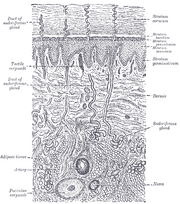Assessment |
Biopsychology |
Comparative |
Cognitive |
Developmental |
Language |
Individual differences |
Personality |
Philosophy |
Social |
Methods |
Statistics |
Clinical |
Educational |
Industrial |
Professional items |
World psychology |
Biological: Behavioural genetics · Evolutionary psychology · Neuroanatomy · Neurochemistry · Neuroendocrinology · Neuroscience · Psychoneuroimmunology · Physiological Psychology · Psychopharmacology (Index, Outline)
| Eccrine sweat gland | |
|---|---|
| Latin | glandula sudorifera merocrina; glandula sudorifera eccrina |
| Code | TH H3.12.00.3.03009 |

A sectional view of the skin (magnified). Sweat gland labeled as "sudoriferous gland" at center right. This is the most common sweat gland in the body.
Eccrine sweat glands, (or merocrine glands are sweat glands which are distributed over the entire body surface. in the process of sweating they produce sweat These glands, by affecting skin temperature play a role in are used for body temperature regulation.
They are are the major sweat glands of the human body, found in virtually all skin.[1].
Anatomy
Eccrine sweat glands are coiled tubular glands derived from the outer layer of skin but extending into the inner layer. They are distributed over almost the entire surface of the body in humans and many other species, but are lacking in some marine and fur-bearing species. Eccrine glands are composed of (1) an intreaepidermal spiral duct, the "acrosyringium," (2) a straight dermal portion, and (3) a coiled acinar (grape like) portion in the dermis or hypodermis. Innervation is by the sympathetic nervous system, by primarily cholinergic fibers, but also adrenergic fibers[2]. The sweat glands are controlled by sympathetic cholinergic nerves which are controlled by a centre in the hypothalamus. The hypothalamus senses core body temperature directly, and also has input from temperature receptors in the skin and modifies the sweat output, along with other thermoregulatory processes.
Product
Human eccrine sweat is composed chiefly of water with various salts and organic compounds in solution. It contains minute amounts of fatty materials, urea, and other wastes. The concentration of sodium varies from 35–65 mmol/l and is lower in people acclimatised to a hot environment. The sweat of other species generally differ in composition.
See also
- Apocrine glands
- Exocrine glands
- Exocrine system
- Sebaceous sweat glands
References
- ↑ James, William; Berger, Timothy; Elston, Dirk (2005) Andrews' Diseases of the Skin: Clinical Dermatology (10th ed.). Saunders. Page 6-7. ISBN 0-7216-2921-0.
- ↑ Sokolov VE, Shabadash SA, Zelikina TI. Biol Bull Acad Sci USSR. 1980 Sep-Oct;7(5):331-46. Innervation of eccrine sweat glands. http://www.ncbi.nlm.nih.gov/pubmed/7317512
External links
Integumentary system | |
|---|---|
| Structures |
Skin • Sweat glands • Sebaceous glands • Hair (Hair follicle) • Nails • Scale |
| Layers |
Cutis: Epidermis (Stratum corneum, Stratum lucidum, Stratum granulosum, Stratum spinosum, Stratum germinativum/basale) • Dermis |